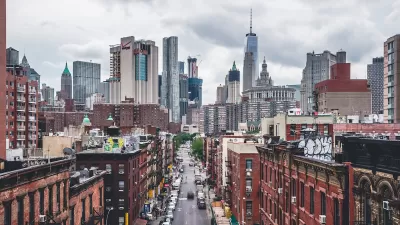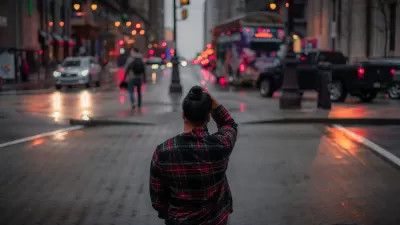After visiting Denver for the Congress for New Urbanism (CNU) conference, I began to meditate on the relationship between Judaism and urbanism, and on how few cities accommodate both. In particular, I was impressed by how well-populated downtown Denver was compared to the southern cities where I have spent the past three years (Jacksonville) and this summer (Little Rock) - but I stll couldn’t imagine myself living in downtown Denver all that comfortably.
After visiting Denver for the Congress for New Urbanism (CNU) conference, I began to meditate on the relationship between Judaism and urbanism, and on how few cities accommodate both. In particular, I was impressed by how well-populated downtown Denver was compared to the southern cities where I have spent the past three years (Jacksonville) and this summer (Little Rock) - but I stll couldn't imagine myself living in downtown Denver all that comfortably.
Why? Because, like many Orthodox and Conservative* Jews, I seek to follow the rule of Jewish law that one should walk, rather than drive or take public transit, to a synagogue on the Sabbath - and the nearest synagogue is three or four miles away, kind of a long walk. If I could live anywhere (rather than being limited by my love for my job) I would prefer to live in a city where I can have my urbanism and my Judaism too.
How do American cities stack up in this regard? I think American cities can be divided into four categories:
Grade A, or The Gold Standard: Cities with large downtown Jewish populations. The true "gold standard" in this regard is of course New York City, where there are synagogues in virtually every neighborhood, and the full panopoly of Jewish options near Midtown. Philadelphia also has downtown synagogues of all stripes (though, alas, no Jewish day school downtown).
Grade B, or Some Life Downtown: Cities with just enough of a core population to support a downtown synagogue or two, plus other congregations in pedestrian- and transit-friendly city neighborhoods. For example, Washington has a couple of downtown congregations, and several more elsewhere in the District of Columbia. But most of Washington's Jews live in the suburbs or in "outer city" (within the city limits, but not near downtown) neighborhoods such as Cleveland Park. Similarly, Pittsburgh has a downtown synagogue, but most of its urban Jews live in outer city Squirrel Hill a few miles away.
Grade C, or Take The Bus: Cities where there is no downtown religious life to speak of, but you can have a full Jewish life if you are willing to take a bus or train from an intown neighborhood a few miles away.
Denver is an excellent example: although there is no downtown synagogue, there are congregations in intown neighborhoods with reasonably good bus service, so you can live in a more-or-less urban neighborhood with ample transit options and still have an adequate Jewish religious life. Similarly, in Jacksonville almost all local synagogues are on the same bus route (though in a setting that is more suburban and less walkable).
Grade D, or Sprawl Hell: In these desolate places, the Jewish population is concentrated in suburbs with minimal or nonexistent transit service. Kansas City presents a dismal example. Only two synagogues (one Reform and one Conservative) are left in the city of Kansas City, and the Conservative one has already moved many of its operations to the Kansas suburbs where the rest of the Jewish population is concentrated. In these Kansas suburbs, most buses stop running around 5:30 PM. Ironically, in Kansas one must have a car to live in a place where one can walk to most synagogues.
(In Grade F cities, there are no synagogues, so the issue is moot).

Manufactured Crisis: Losing the Nation’s Largest Source of Unsubsidized Affordable Housing
Manufactured housing communities have long been an affordable housing option for millions of people living in the U.S., but that affordability is disappearing rapidly. How did we get here?

Americans May Be Stuck — But Why?
Americans are moving a lot less than they once did, and that is a problem. While Yoni Applebaum, in his highly-publicized article Stuck, gets the reasons badly wrong, it's still important to ask: why are we moving so much less than before?

Using Old Oil and Gas Wells for Green Energy Storage
Penn State researchers have found that repurposing abandoned oil and gas wells for geothermal-assisted compressed-air energy storage can boost efficiency, reduce environmental risks, and support clean energy and job transitions.

Greening Oakland’s School Grounds
With help from community partners like the Trust for Public Land, Oakland Unified School District is turning barren, asphalt-covered schoolyards into vibrant, green spaces that support outdoor learning, play, and student well-being.

California Governor Suspends CEQA Reviews for Utilities in Fire Areas
Utility restoration efforts in areas affected by the January wildfires in Los Angeles will be exempt from environmental regulations to speed up the rebuilding of essential infrastructure.

Native American Communities Prepare to Lead on Environmental Stewardship
In the face of federal threats to public lands and conservation efforts, indigenous groups continue to model nature-centered conservation efforts.
Urban Design for Planners 1: Software Tools
This six-course series explores essential urban design concepts using open source software and equips planners with the tools they need to participate fully in the urban design process.
Planning for Universal Design
Learn the tools for implementing Universal Design in planning regulations.
Heyer Gruel & Associates PA
City of Moreno Valley
Institute for Housing and Urban Development Studies (IHS)
City of Grandview
Harvard GSD Executive Education
Salt Lake City
NYU Wagner Graduate School of Public Service
City of Cambridge, Maryland






























